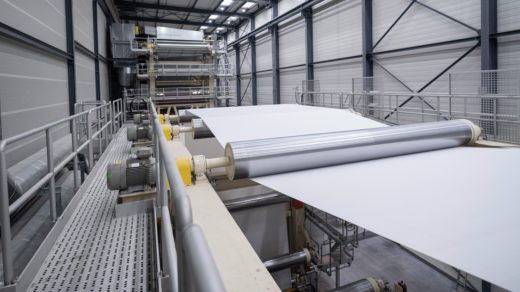FOREIGNERS DOMINATING PULP AND PAPER INDUSTRY
Foreign foothold
Sojitz has a long history of contributing to Vietnam’s development in various business fields. With more than 20 companies in the country, it contributes to improving living standards and business sectors relating to consumer lifestyles. “We will work to strengthen SGP’s manufacturing infrastructure for sanitary and industrial paper to meet the increasing demand for paper products in Vietnam,” said Mr. Jun Morita, CEO of SGP.
SGP is the only company that can produce both sanitary and packaging paper, and is among Vietnam’s leading manufacturers of sanitary paper products, which include toilet rolls, napkins, tissues and others. The company’s leading sanitary paper brands, including “Bless You” and “Saigon”, are among the market leaders in terms of market value share and distribution nationwide. In terms of industrial paper, SGP is among the Top 4 mills with 50 per cent capacity in the domestic market.
Sales in 2017 reached around $130 million with growth of more than 20 per cent year-on-year, compared to an industry average of 10 per cent. Its designed capacity is 273,000 tons per year and actual capacity in 2017 reached more than 80 per cent of designed capacity. Revenue was lost in the first quarter of 2018 due to a fire incident, but reached almost 90 per cent of the figure recorded in the same period of 2017.
Vietnam’s pulp and paper industry has been dominated by foreign enterprises in recent years and this is likely to continue given that SGP held a share of around 30 per cent of household paper products. Foreign companies dominate as they are primarily involved in packaging paper production, according to Mr. Vu Ngoc Bao, former General Secretary of the Vietnam Pulp and Paper Association (VPPA).
Major producers in Vietnam’s paper industry are Chanh Duong, VinaKraft, Lee & Man, SGP, and Dong Hai Ben Tre. Bao Viet Securities (BVSC) has estimated that these five companies currently account for 76 per cent of capacity in the industry. “One of the greatest barriers to entry into this industry is investment capital, as paper manufacturing requires substantial investment,” said Ms. Che Thi Mai Trang, Senior Analyst at BVSC. “This is why foreign investors are the main players, with the local competition generally being small factories with a capacity of less than 50,000 tons per annum.”
SGP and Dong Hai Ben Tre are the largest local enterprises while An Binh Paper, the third largest, has a capacity of just 80,000 tons per annum. “Therefore, as foreign investors become interested in Vietnam’s paper industry, I think they will choose to establish new plants with high capacity and integrated technology instead of looking at merger and acquisitions (M&As) with small Vietnamese companies,” Ms. Trang said. “SGP is the exception, because of its famous brand and high capacity among local suppliers.”
Mr. Bao said the expansion of foreign paper manufacturers added 1.17 million tons of packaging paper capacity in 2017, or 40 per cent of total capacity. The increase brought the total capacity of FDI companies to 1.52 million tons of packaging paper last year, accounting for 50 per cent. This added capacity, however, mainly comes from three major foreign paper manufacturers.
Vina Kraft, a joint venture between Siam Kraft Industry, a subsidiary of Thailand’s Siam Cement Group (SCG), and Japan’s Rengo Co., last year put into operation its second paper and packaging plant, in southern Binh Duong province. The company’s total production capacity is now set to reach 500,000 tons per year. Meanwhile, Hong Kong – China’s Lee & Man Paper Manufacturing also started a recycled containerboard plant with an annual capacity of 400,000 tons in the Mekong Delta’s Hau Giang province, in 2017. It recently started the second phase of its expansion and is expected to double sales within the next two years.
The Taiwan-based Cheng Loong Binh Duong Paper was granted an investment license to develop a $1 billion paper mill in Binh Duong three years ago. Covering an area of 75 ha, the mill is designed to produce 1 million tons of industrial paper and 50,000 tons of household paper per year. The first phase is slated to be put into operation this year, with an installed annual capacity of 300,000 tons of industrial paper products.
Market potential
Vietnam is projected to have one of the strongest paper industries in ASEAN within the next few years, trailing only Indonesia and overtaking Thailand, according to Mr. Bao. The ongoing foreign investment is testament to the local industry’s vast potential for development. It is projected that total capacity of FDI companies will reach 5 million tons in the years to come, making Vietnam a leading paper manufacturer in the region.
The local paper industry saw a significant increase of 60 per cent in paper output in the first four months of 2018 thanks to completed expansion projects and new operations, Ms. Trang noted. According to market researchers RISI, Vietnam’s industrial paper capacity rose to 2.4 million tons in 2017, or 36 per cent higher than in 2016. Capacity this year is estimated at 2.86 million tons, an increase of 19 per cent.
Vietnam has seen double-digit growth in both industrial paper consumption and sanitary paper consumption over last past five years and this should remain steady over the next five years, according to SGP. Sanitary paper consumption in the country is rather low, at 0.8 kg per person per year, compared to a global average of 4.5 kg. “Industrial paper such as chipboard, medium, sizing medium, tesliner, and sanitary paper like tissue and toilet rolls are essential products for a better and more comfortable life,” said Mr. Morita from SGP. “Demand for such products is certain to increase steadily in line with the country’s economic growth.”
As Vietnam’s GDP growth rises steadily and paves the way to more modern lifestyles and modernized distribution and retail techniques, demand is growing for household paper products such as tissues as well as containerboard used in packaging. Cardboard demand in Vietnam has surged more than ten-fold over the past decade, benefiting from the rise in online shopping and the relocation of textile and electronics production to the country from China.
Local barriers
Vietnam’s paper industry is quite attractive due to the growth potential of consumer goods and exports along with existing low consumption per capita, according to Ms. Trang. “The local paper industry is therefore forecast to maintain high growth of about 9 per cent per annum in the next ten years,” she said. “The competition, however, will be much more intense in the years to come as large projects were put into operation in 2017 and we only needed to import about 400,000 tons of industrial paper in 2018 compared to 1.6 million tons in previous years.”
Furthermore, insufficient raw materials have been the biggest problem for Vietnam’s paper industry, as the country must import most requirements for production. Local customs authorities recently issued documents limiting the import of scrap paper, which has created a range of difficulties for paper manufacturers. Mr. Morita revealed that SGP has had problems in this regard, and it is trying to collect materials and investing further in waste collection centers, which have risen from seven to nine this year.
Vietnam’s reliance on imported pulp and paper creates difficulties in local production. The country has imported most of its input materials from Indonesia and sourced high-end packaging paper from Taiwan, South Korea, and Japan to meet production demand. It is also sourcing printing and writing paper from Thailand, as there are too few domestic producers of printing paper to meet local market demand.
Manufacturers as well as traders agree that domestic supply has yet to meet production demand, as the local industry primarily depends on imported raw materials. This, coupled with the rising price of these inputs, leads to an increase in prices for different types of paper. Therefore, local manufacturers need to restructure and develop new and modern paper mills with larger capacity to increase their competitiveness, Mr. Bao said.

VN Economic Times









